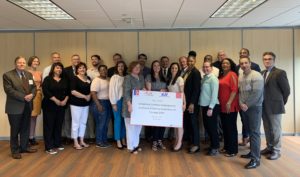
Last week, the Bureau of Justice Assistance (BJA) celebrated their 40th anniversary. Members of the Racial and Ethnic Disparities Initiative (REDI) team at American University (AU)–Matt Collinson, Preeti Menon, and I–travelled to the U.S. Department of Justice to share in this historic occasion. We were surrounded by staff, partners, and grantees who have been essential in executing BJA’s mission of making communities safer and creating a more equitable criminal justice system. Hearing about the successes BJA has had over the years was inspiring, such as advancements in training, guidelines, and practices for the areas of law enforcement, courts, and reducing violent crime. At the ceremony, there was a video presentation that highlighted many of BJA’s accomplishments, including the creation of the Drug Courts Program Office in 1995, which awarded jurisdictions and court systems funding to establish drug courts through the Drug Court Discretionary Grant Program.
Attending this event gave me the valuable opportunity to reflect on the decades-long partnership between BJA and AU. Over the past 30 years, AU has partnered with BJA on several initiatives such as Drug Treatment Courts, Right to Counsel, Criminal Courts Technical Assistance Project, Differentiated Case Management Program, Pandemic Influenza Preparedness for Courts, Project Safe Neighborhoods, and numerous justice roundtables.
Specifically, this anniversary brings to mind where my journey with AU and BJA started, and where it may take me next. I vividly remember that day in 2017 when I was invited to interview for a research position at the Justice Programs Office (currently Justice Initiatives) housed in the School of Public Affairs (SPA) at AU. I hopped in a car and drove from my home state of Delaware to the District of Columbia. During the interview, I learned about the National Drug Court Resource Center (NDCRC), which was a multi-year project funded by BJA. NDCRC’s deliverables involved hosting interactive webinars, producing podcast episodes, conducting trainings at conferences, publishing research in the Drug Court Review, and administering the national treatment court survey. Overall, the mission of NDCRC was to provide resources and research to help treatment courts run more effectively. After the meeting, I felt confident that this would be a great opportunity for me, as I would be joining a team that was passionate about making the justice system more equitable for all. Sure enough, a short time later I officially started working at AU as a member of the NDCRC team. Below are a few NDCRC project highlights:
- A drug court explainer video;
- A podcast series—Color in the Court: Exploring Racial and Ethnic Disparities in Treatment Courts; and
- The Racial and Ethnic Disparities (RED) Program Assessment Tool (RED tool), which is a resource to help treatment court teams identify and rectify disparities in their programs.
On my second day at AU, I attended the Right to Counsel (R2C) National Consortium’s Third Annual Meeting. BJA sponsored the Right to Counsel National Campaign (a campaign designed to raise awareness about the importance of effective defense counsel representation, as an important factor in ensuring equity in the system). At this annual meeting, there was a fireside chat between AU’s Senior Policy Counsel, Zoe Root, and Tracey Sewell, a former client and a survivor of human trafficking. Zoe, a former public defender at the Bronx defenders, represented Tracey and filed a successful motion to vacate Tracey’s 31 convictions that she accrued at the hands of her traffickers. Tracey shared how having an effective public defender helped her get back on the right track in life, including having her criminal record expunged, so that she could obtain better employment opportunities. I was able to witness first-hand the necessity and power of the Sixth Amendment and R2C’s achievements, including:
- A report on Americans’ Views on Public Defenders and the Right to Counsel;
- A webinar about The Face of Gideon: A Conversation with Public Defenders and Former Clients; and
- A report on Engaging Key System Actors in Support of the Right to Counsel.
The last BJA-funded project that will be spotlighted is the Racial and Ethnic Disparities Initiative (REDI). In the spring of 2022, I received a phone call from Preeti about the news of a BJA open solicitation called Field Initiated: Encouraging Innovation. After our chat, we knew this would be a perfect chance for us to scale up our RED work in treatment courts at a national level. We applied and waited several months to find out about a decision. In September of that year, Preeti and I were both on campus preparing for a documentary screening and a panel discussion about the Definition of Insanity and she checked her phone and received an email notifying us that we had been awarded the funding! Preeti and I were ecstatic that this grant would allow us to work with treatment courts to increase access, enhance retention, and improve overall program satisfaction for minoritized treatment court participants. Here are a few project milestones:
- A webinar on Ensuring Racial and Ethnic Minorities Succeed in Treatment Court;
- Issue briefs on racial equity training and data collection and monitoring; and
- Developing new tracks (Juvenile Drug Treatment Court, Family Treatment Court, and Mental Health Court) for the RED tool with accompanying online modules (forthcoming).
In a world that is always on the move, it is important to pause and soak in what has been accomplished. I am grateful for the opportunity to celebrate BJA’s 40th anniversary alongside the REDI team and reflect on the partnership BJA and AU have maintained over the years. I am looking forward to many more years of collaboration as we strive to create safer communities and a more equitable criminal justice system.
To learn more about BJA’s 40th anniversary, visit here.



 I first learned about the concept of procedural fairness within justice systems in the early 2000s while working at the Department of Justice. The concept seems quite intuitive to me yet when observing court practices, I was struck by how many courts don’t naturally incorporate the elements of procedural fairness into their daily work.
I first learned about the concept of procedural fairness within justice systems in the early 2000s while working at the Department of Justice. The concept seems quite intuitive to me yet when observing court practices, I was struck by how many courts don’t naturally incorporate the elements of procedural fairness into their daily work.
 Last month, California congresswoman and Democratic presidential candidate Kamala Harris introduced the
Last month, California congresswoman and Democratic presidential candidate Kamala Harris introduced the  Last week, in partnership with the
Last week, in partnership with the 

